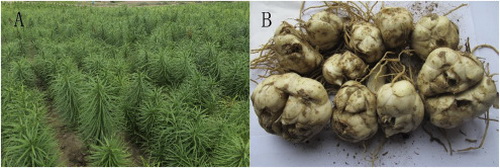The Occurrence and Distribution of Viruses Infecting Lanzhou Lily in Northwest, China
Updatetime:2018-05-25From:
【Enlarge】【Reduce】
Lanzhou lily is a popular edibel vegetable bulb, as well as a traditional medicinal plant with a 150-year cultivation history. Lanzhou lily is mostly grown in the central area of Gansu province in northwestern China, and it is mainly propagated via bulbs. Nearly 25% of the cultivated area at elevations of 1800-2600 m has been planted with this crop.
During the past decade, the economic importance of Lanzhou lily bulb production has increased because of a rapid increase in demand in both domestic and international markets. However, in recent years, virus infected plants exhibiting symptoms of plant stunting, have become a major problem. More than ten different viruses have been reported to infect lilies worldwide.
Recently, scientists from Northwest Institute of Eco-Environment and Resources surveyed the major producer of Lanzhou lily and collected the study specimens from fields at the Gaolan Research Staion.
They documented the occurence of multiple virus infections and recorded predominant viruses infecting Lanzhou lily in the major area of cultivation during 2015-2016.
Results indicated a high level of Lily symptomless virus (LSV) (98.2%), a high level of Cucumber mosaic virus (CMV) (42.5%), and a low level of Lily mottle virus (LMoV) (1.5%).
In addition, a high level of mixed infections of LSV+CMV was confirmed in Lanzhou lily; in Huangyu, north Yuzhong and Yongjing, incidence of mixed infections of LSV+CMV occurred in over 50% of plants. Interestingly, 99% of CMV-infected plants were in combination with LSV.
The sequence homology of LMoV isolate from this study was similar to that previously reported in this region from Lilium oriental.
Besides, this study also discussed the disease control using improved virus detection methods.

Lanzhou lily (lilium davidii var. unicolor); A. A crop in the field; B. Harvested bulbs.
Appendix




